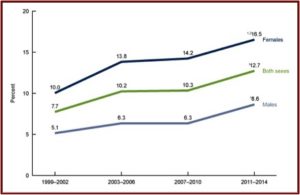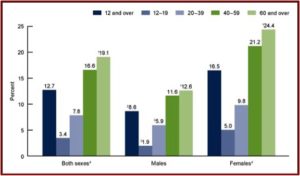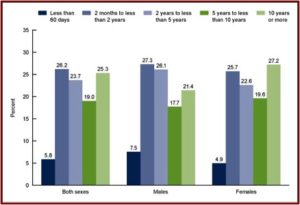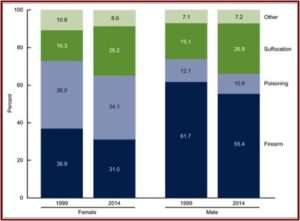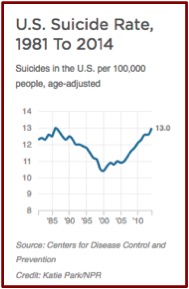Fighting or Fueling Suicide with Antidepressants?

England has pulled ahead of the U.S. in its willingness to recognize and act on adverse effects with antidepressants. In May of 2019, the Royal College of Psychiatrists revised its position on antidepressant withdrawal. In its “Position statement on antidepressants and depression,” it stated the routine use of antidepressants for mild and sub-threshold depressive symptoms among adults was not generally recommended. Discontinuation should be done with a slow taper in order to reduce the risk of withdrawal symptoms. “Ongoing monitoring is also needed to distinguish the features of antidepressant withdrawal from emerging symptoms which may indicate a relapse of depression.” Now there is evidence that antidepressants significantly raise the risk of suicide for adults.
In June of 2019, Hengartner and Plöderl published a study that found depressed adults who start treatment with antidepressants are 2.5 times more likely to attempt suicide when compared to placebo. The study reanalyzed the safety summaries submitted to the FDA for new generation antidepressants (SSRI, SNRI and atypical serotonergic-nonadrenergic antidepressants like Remeron (mirtazapine). They found the rate of attempted suicide was about 2.5 times higher with those adults taking antidepressants rather than placebo. CEP, the Council for Evidence-Based Psychiatry, said Hengartner and Plöderl examined all the suicides and suicide attempts recorded in the safety summaries of all antidepressant trials submitted to the FDA between 1987 and 2013.
Based on this, the study estimates the absolute risk increase in the rate of both fatal and non-fatal suicide attempts for antidepressants vs placebo to be about 0.5%, which is statistically a highly significant effect. While this study does not attempt to identify the precise cause, other studies have suggested that rare adverse drug reactions such as akathisia or extreme agitation, as well as severe withdrawal reactions upon stopping the drug, may increase the suicide risk.
Earlier analysis of the data did not reveal the increased suicide risk because the method used in those clinical trials to analyze the data was incorrect. Previous calculations were based on ‘person exposure years’ (PEY) rather than the number of patients receiving treatment. Hengartner and Plöderl said PEY was not the correct method here because it assumes that the hazards (i.e. the suicide risk) remain constant over time. Yet the evidence shows that the highest suicide risk occurred in the first four weeks after the start of treatment, as well as shortly after the drug has been stopped. “Thus, when based on the number of patients randomized rather than PEY, the data presented herein suggest that antidepressants significantly increase the suicide risk in adults with major depression.”
Writing for the Mental Elf, Douglas Badenoch agreed with this conclusion. He began his review of the study by acknowledging the difficulty of studying suicide in prospective trials because it is such a rare event. It’s hard to combine the findings of such studies because they usually look at different things. Additionally, there is a risk of attrition bias, when patients who experience adverse effects withdraw from the trials. “These factors on their own may account for the apparently contradictory findings across studies of suicide in antidepressant use in general.”
He agreed that it was problematic to use PEY as an outcome measure; that it could result in under-estimating short-term harmful effects. “Most suicide attempts occur within the first 3-4 weeks of treatment, so factoring in further exposure time to the outcome measure only serves to reduce its sensitivity.” He said patients, parents and others need to be aware of the small, although increased, risk. These risks need to be balanced against the risks of withdrawing or withholding antidepressants. Nevertheless, “There is strong evidence here that antidepressant treatment may trigger suicide in adults with depression. The use of patient-exposure-years as an outcome may have masked this short-term effect in some previous studies.”
Writing for Mad in America, Peter Simons noted that a new study in Denmark found antidepressants were ineffective in preventing suicides. Approximately 20% of participants attempted suicide after being hospitalized for depression, “whether they took antidepressants or not.” They found a significant spike in suicides right after initiating antidepressants. The incidence of suicide was 3-4 times higher during the first 28 days after initiation compared to the following year. The incidence of suicide was stable at a low level among participants not treated with antidepressants.
Hengartner and Plöderl are no strangers to critiquing antidepressants. They previously demonstrated how statistical significance with drug-placebo trials does not imply clinical significance. “A statistically significant result neither proves that the null hypothesis is false nor that the alternative hypothesis is true.” They said interpreting a statistically significant drug-placebo difference as evidence that drug work was a logical fallacy. “Thus, since statistical significance does not imply clinical significance, readers need to consider what the reported mean effect of d = 0.3 practically means.”
This effect size corresponds to around 2 points on the Hamilton Rating Scale for Depression, which was used by the clinical trials in their analysis to test for significance. Yet it is generally agreed that a difference of < 3 points, or an effect size where d = 0.5 (corresponding to < 4 HAMD-17 points) are clinically irrelevant. “Research suggests that drug-placebo differences < 3 points are undetectable by clinicians and that at least 7 HAMD-17 points are necessary for a clinician to detect a minimal improvement in a patient’s clinical presentation.” They concluded the average treatment effect of d = 0.3 must be considered undetectable and clinically insignificant in real world practice. See Figure 1 in the linked article for a chart that illustrates this.
Frequently it is said that the effect of antidepressants is comparable to other medications in general medicine. However, several medicine drugs have effect sizes where d > 0.8, where the effect size of antidepressants is d = 0.3. In addition, the general medicine drugs with small effect sizes were mostly based on objective, severe clinical outcomes, such as mortality or cardiovascular events. In contrast, efficacy with antidepressants was exclusively based on subjective symptom ratings with the HAMD-17 scale.
To provide a fair comparison of the efficacy of antidepressants and general medicine drugs, researchers should base the effect size of antidepressants likewise on a severe clinical outcome such as for instance (fatal) suicide attempts. In that case the effect size of antidepressants would be close to zero and favoring placebo. This compares very unfavorably to most general medicine drugs.
As noted above with the Royal College of Psychiatrists, there is a growing willingness to acknowledge evidence for the adverse effects and ineffectiveness of existing antidepressants. However, there is still is a well-entrenched belief in the value of antidepressants. Hengartner and Plöderl suggest that the treatment effect of antidepressants “is most likely an overestimation due to systematic biases that inflate the apparent efficacy of antidepressants.” They conclude that:
Contrary to the predominant interpretation we contend that antidepressants do not work in most patients, given that only 1 of 9 people benefit, whereas the remaining 8 are unnecessarily put at risk of adverse drug effects. To be clear, antidepressants can have strong mental and physical effects in some patients that may be considered helpful for some time, but there is no evidence that the drugs can cure depression. Insomnia, fatigue, loss of appetite, psychomotor agitation, and suicidal acts are recognized depression symptoms, but newer-generation antidepressants may cause precisely these symptoms. This is not what we would expect from drugs that effectively treat depression. Moreover, emerging evidence from well-controlled long-term pharmacoepidemiologic studies suggests that antidepressants may increase this risk of serious medical conditions, including dementia, stroke, obesity, and all-cause mortality. Antidepressants may have clinically meaningful short-term benefits in a small minority of patients, but the most recent meta-analytic evidence does not indicate that they work in the majority of patients. A careful re-evaluation of risks and benefits is therefore needed before the controversy about the utility of antidepressants can be put to bed.
So sertraline (Zoloft), paroxetine (Paxil), venlafaxine (Effexor), nefazodone (Serzone), mirtazapine (Remeron), venlafaxine ER (Effexor ER), citalopram (Celexa), escitalopram (Lexapro), duloxetine (Cymbalta), desvenlafaxine (Pristiq), trazodone ER, vilazodone (Viibryd), levomilnacipram (Fetzima), or vortioxetine (Brintellix) are of questionable efficacy, with only 1 in 9 patients gaining some benefit. Fluoxetine (Prozac) and bupropion (Wellbutrin, Zyban) were excluded from the study only because of a lack of pertinent data on PEY, not because of their efficacy. See “Following the Leader with Antidepressants” for more on the ineffectiveness of antidepressants.
But pharmaceutical companies aren’t ready to throw in the towel just yet. Instead of re-evaluating the risks and benefits with antidepressants, they are moving on to a new drug approach. In March of 2019, the FDA approved Spravato for the treatment of severely depressed patients with treatment resistant depression. This was the first legitimately new kind of depression drug since Prozac in 1988. However, there were questions with the approval process. Kaiser Health News reported there was only modest evidence of Spravato’s effectiveness. There was no information on its safety beyond 60 weeks (Spravato is a Schedule III Controlled Substance); and three patients died by suicide during the clinical trials. See “Red Flags with Spravato” and “Better Living Through Spravato?” for more on this issue.
Despite questions regarding the FDA approval of Spravato, Johnson & Johnson is now trying to add FDA approval for Spravato to treat depressed, suicidal patients. Towards that end, Janssen Pharmaceutical Companies of Johnson & Johnson announced positive results from two Phase 3 clinical studies in adult patients with active suicidal ideation. The findings were presented at the 32nd European College of Neuropsychopharmacology in Copenhagen, Denmark. While there is a growing consensus on the ineffectiveness of antidepressants and clear evidence that existing antidepressants are ineffective in treating suicidality, does it make sense to expand the approved FDA treatments for the latest antidepressant to include suicidality?


